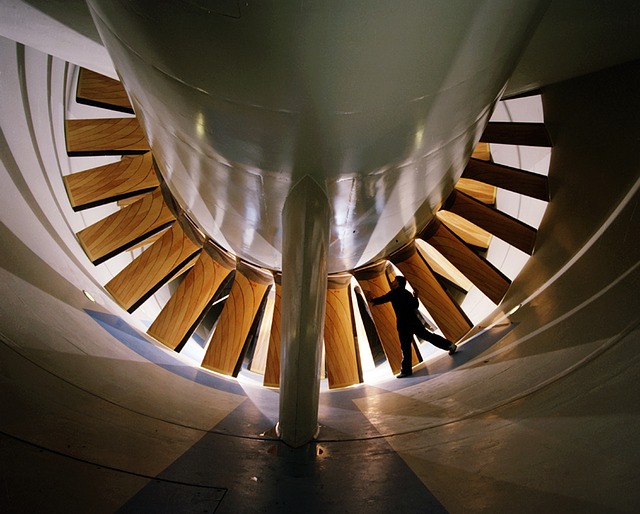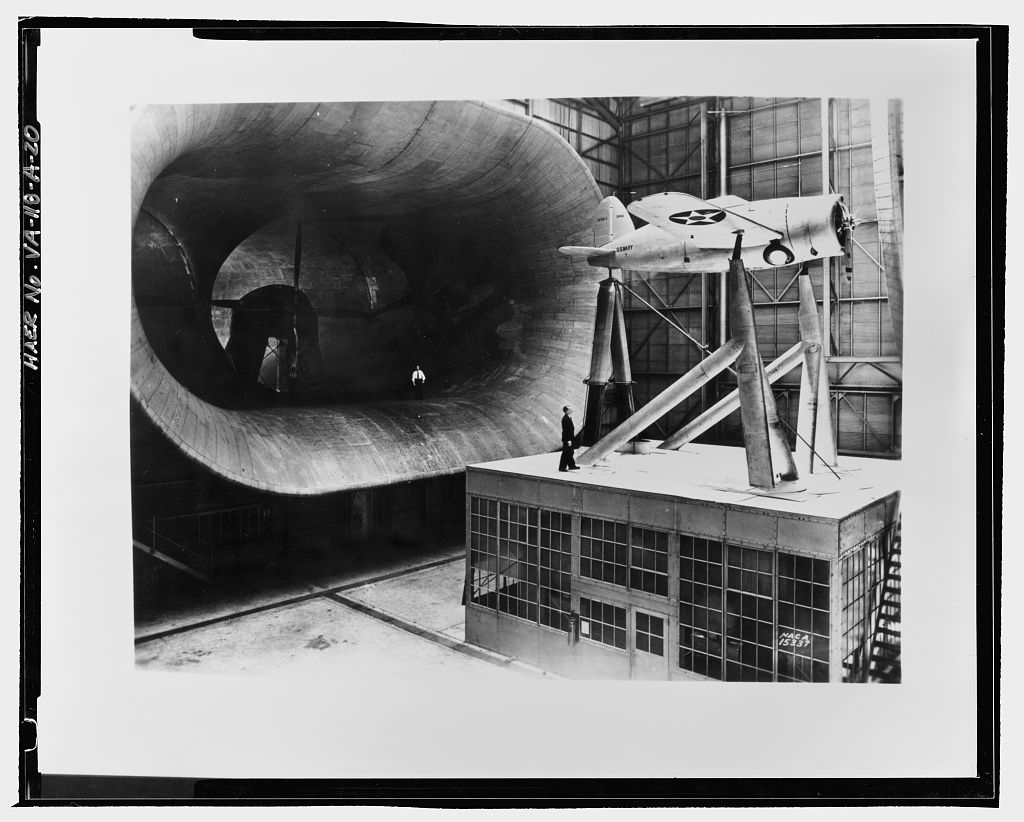Wind tunnel

|
| NASA transonic wind tunnel |
Contents |
[edit] Introduction
A wind tunnel is a device which produces a strong, controlled stream of air to enable the study of the effects of winds and air flow on objects such as cars, aircraft and buildings.
In the 1800's Sir George Cayley identified the inter-related aerodynamic forces of flight as being, weight, lift, drag, and thrust, whilst towards the end of the same century Francis Herbert Wenham constructed the first wind tunnel, allowing precise measurements of aerodynamic forces. Aerodynamic principles were then first put into practice in 1871 by the French inventor, Alphonse Pénaud with his model aeroplane called the Planophore, the first aerodynamically stable flying mode with a wind up rear propeller.
In the years prior to their historic flight of 1903 the Wright brothers themselves built a small, 6-foot-long wind tunnel to test scale models of wing sections before embarking on their first sustained flight by a manned heavier-than-air powered and controlled aircraft in the Wright Flyer (or Kitty Hawk).
Gustave Eiffel built the first open-return wind tunnel in 1909, at Champs-de-Mars, near the foot of the tower that bears his name, it ran about 4,000 tests up to 1912, setting new standards for aeronautical research. In 1907 with the foundation of an experimental facility, Ludwig Prandtl (regarded as the founder of fluid dynamics) built the first Göttinger type of wind tunnel, Eiffel's wind tunnel this featured a closed cycle for liquids or gases to flow in and was the starting point of the later Aerodynamical Experimental Station founded in Göttinger in 1915.
As the early beginnings of the aviation industry had commenced, some 15 years later the first full-scale wind tunnel building was constructed and able to test the aerodynamics of flight on the ground. At Langley Field near Hampton, Virginia a 9x18 metre aerodynamic test centre was built in the 30's, testing World War II fighters and space capsules to submarines and jets.
The wind tunnel played a major role during the Second World War and saw further development for the testing of supersonic aircraft during the Cold War. It has developed largely in parallel with the development of aircraft generally and the increasing height of buildings. Wind tunnels can show the optimal design for aerodynamics and wind loading on the ever-increasing surface areas of tall buildings.
The basic structure of a wind tunnel comprises a tube of circular section with a large fan at one end. Circular section, smooth-surfaced tunnels have become the norm as being square produces turbulence due to the corners. Later variants involve air being sucked out at great force to achieve the same effect and may have a series of fans depending on the wind-speed required.
[edit] Observing air flows
Once a stream of air is pushed through the tunnel, a means is required to observe the air flows around the placed objects. This is usually achieved by various means such as:
- Adding smoke or dye to the air.
- Attaching threads or tufts of yarn to the object.
- Attaching gauges to measure the air pressure at various points.
- Using helium-filled bubbles to show vortices paths on wing tips.
. Typically, wind tunnels may be able to replicate a variety of windspeeds:
- Subsonic (Mach* 0.8).
- Transonic (Mach 1).
- Supersonic (approximately Mach 6).
- Hypersonic (Mach 6-12)
- Hypervelocity (Mach 12+).
(Mach is a term used to describe the ratio of an object's speed to the speed of sound. So, Mach 1 is equal to the speed of sound, Mach 2 is twice the speed of sound, Mach 3 three times….and so on.)
High-speed travel usually generates high temperatures on wing tips and other areas. Such scenarios are replicated by heating the air passing through the tunnel to an appropriate temperature, often higher than the melting point of the material being tested.
In the case of buildings and aircraft, scale models are positioned inside the tube and secured tightly in place to determine the effects of applied wind or movement through the air, however some wind tunnels are large enough to accommodate full-size cars, car body parts and even full-size aircraft.
[edit] Buildings
Wind tunnel testing of buildings can improve occupant comfort and safety, save on construction costs and help achieve highly individual architectures that might otherwise not have been possible. It is also increasingly used to improve the pedestrian experience, to avoid being blown off course by strong winds which can occur at ground level due to tall-building aerodynamics.
Wind tunnel tests may be conducted on:
- Tall buildings and skyscrapers.
- Other tall structures.
- Clusters of buildings to determine aerodynamic interference.
- Cladding assemblies.
- Long-span or unusual-shaped roofs.
- Long-span bridges.
Typically, wind tunnel testing is usually undertaken during the early planning stages and where the building:
- Is over 22-storeys in height (or 10 storeys if in a hurricane zone).
- Has an unusual geometry or construction.
- May be adversely affected by surrounding structures.
- Is located amid unusual terrain.
Wind tunnel testing can show how wind flows up, down and around a building, and the sorts of loadings that will have to be borne by the structural frame, whether pushing or suction forces, particularly important for the highest reaches.
Building codes have responded in kind – once wind loads acting on a building are established, codes can be drawn up to ensure structures are robust enough to withstand them. Wind-tunnel testing is particularly useful where a building has an irregular shape.
NB BREEAM UK New Construction, Non-domestic Buildings (United Kingdom), Technical Manual, SD5078: BREEAM UK New Construction 2018 3.0, published by BRE Global Limited defines wind tunnel modelling as: ‘…a versatile physical technique which allows a large number of variables (for example building design, intake and exhaust positions, local pollutant sources, wind speed and direction), to be investigated for complex urban areas. In particular, wind tunnel modelling provides reliable and detailed data, both visual and quantitative, on outdoor pollution distribution. This enables effective siting of intakes and exhausts for both mechanically and naturally ventilated buildings.’
[edit] Related articles on Designing Buildings Wiki
- Bank of China Tower
- Burj al Arab, Dubai.
- CFD.
- Computational fluid dynamics in building design: An introduction FB 69.
- CN Tower.
- Empire State Building.
- Integrating CFD into the design process.
- Lifts for buildings.
- Lotte World Tower.
- Petronas Twin Towers.
- Skyscraper.
- Structural principles.
- Taipei 101.
- Tallest buildings in the world.
- The Shard.
- Tower.
- Wind adjacent to tall buildings.
Featured articles and news
RTPI leader to become new CIOB Chief Executive Officer
Dr Victoria Hills MRTPI, FICE to take over after Caroline Gumble’s departure.
Social and affordable housing, a long term plan for delivery
The “Delivering a Decade of Renewal for Social and Affordable Housing” strategy sets out future path.
A change to adoptive architecture
Effects of global weather warming on architectural detailing, material choice and human interaction.
The proposed publicly owned and backed subsidiary of Homes England, to facilitate new homes.
How big is the problem and what can we do to mitigate the effects?
Overheating guidance and tools for building designers
A number of cool guides to help with the heat.
The UK's Modern Industrial Strategy: A 10 year plan
Previous consultation criticism, current key elements and general support with some persisting reservations.
Building Safety Regulator reforms
New roles, new staff and a new fast track service pave the way for a single construction regulator.
Architectural Technologist CPDs and Communications
CIAT CPD… and how you can do it!
Cooling centres and cool spaces
Managing extreme heat in cities by directing the public to places for heat stress relief and water sources.
Winter gardens: A brief history and warm variations
Extending the season with glass in different forms and terms.
Restoring Great Yarmouth's Winter Gardens
Transforming one of the least sustainable constructions imaginable.
Construction Skills Mission Board launch sector drive
Newly formed government and industry collaboration set strategy for recruiting an additional 100,000 construction workers a year.
New Architects Code comes into effect in September 2025
ARB Architects Code of Conduct and Practice available with ongoing consultation regarding guidance.
Welsh Skills Body (Medr) launches ambitious plan
The new skills body brings together funding and regulation of tertiary education and research for the devolved nation.
Paul Gandy FCIOB announced as next CIOB President
Former Tilbury Douglas CEO takes helm.
UK Infrastructure: A 10 Year Strategy. In brief with reactions
With the National Infrastructure and Service Transformation Authority (NISTA).























